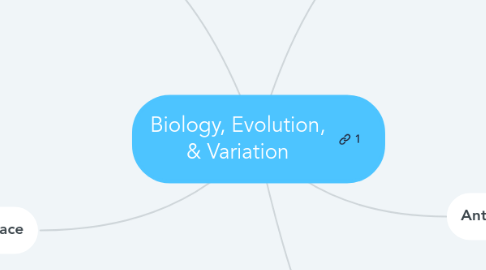Biology, Evolution, & Variation
by Ainsley Blue

1. Evolution Theorists
1.1. Charles Darwin: came up with the evolutionary theory of natural selection
1.2. Fun fact: Darwin came up with his theory of natural selection based on discovering finches in the Galapagos Islands had differences in their beaks, which led to differences in ability to eat, survive, and reproduce
1.3. Gregor Mendel: found that variance allows for difference in traits; also CONNECTS to heredity topic, as genes, which he discovered, are what create our genetic makeup due to heredity
1.4. Both of these men made discoveries that led to helping us understand how us as humans evolved and how other mammalian species evolved as well.
2. Race
2.1. Race is cultural, not biological, therefore not necessarily your skin color, but those in your ethnic group which you have the same biological basis
2.2. Skin Tone: Direct result from solar radiation; influenced by hemoglobin, melanin (blocks UV rays), and carotene
2.2.1. Race is cultural, not biological, therefore not necessarily your skin color, but those in your ethnic group which you have the same biological basis
2.3. Darker skin maintains folate levels
2.4. Interesting Fact: Twins can have different phenotypes, meaning they can appear to be different skin tones, or as we think, races
2.5. The concept that race is cultural shows how diverse all different species are, and how within each species diversity varies. Within one species, like humans, there can be hundreds of different genetic makeups due to heredity and variation, which causes different races to occur.
3. Heredity
3.1. Genotype: genetic makeup of a individual; Phenotype: observable characteristics of a individual
3.2. Alleles are the different versions of genes that result in different expressions of a trait
3.3. Mutations act as a force of evolution, which create genetic variation, causing the evolutionary future and history to be changed in a family or species line. Observing these changes helps us understand our evolutionary history and diversity
3.4. Understanding all of the different types of processes that go on in the reproductive process like mutations and sexual selection with genes roots to the theory of evolution, and how overtime family genetics change and traits become inherent that weren't in the family tree before.
3.5. Interesting fact: females have more to lose when mating since they have limited eggs and energy due to pregnancy
4. Anthropology Types
4.1. Cultural Anthropology: understanding how other societies
4.2. Biological Anthropology: past and present societies being studied
4.3. Linguistic Anthropology: Using language to communicate ideas, beliefs, values, and thoughts
4.4. Interesting fact: humans are the only species that depend on the ability to transmit knowledge via speech and communications
4.5. These disciplines of anthropology make understanding how humans have evolved over time possible: learning about other cultures and comparing them to the culture of our own allows us to learn how cultures and species have changed overtime; learning about how species communicate allows us to learn that humans are the only species that speaks to communicate; and learning about our past and present societies via biological anthropology tells us about how humans change overtime.
5. All main topics are connected:
5.1. Evolution theorists like Mendel and Darwin came up with ideas about evolution due to evidence they found based on genetics and natural selection, which created the fundamental basis for understanding how heredity works, as well as smaller human concepts like race.


